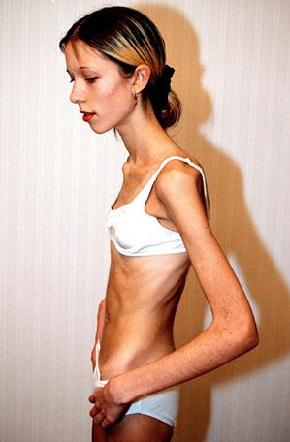While researching material for my final blog, I came across a website dedicated to helping anorexic girls meet their goal of becoming super skinny. While I was on the website, I couldn't believe what I was seeing. I was seeing girls that looked like they were about to die at any moment. Girls writing about only eating an apple for a day and cutting it into 4th's making 4 meals out of an apple. I saw pictures on google and videos on youtube that made me nauseous. Just knowing the some teenage girl is sitting at home watching the same thing as me, only her thinking that being this thin is something good, and something we should strive for.
I cannot believe that "thinspiration" sites even exist. Websites in general make thoughts and ideas much more accessible to many more people than something like word of mouth ever could, so the fact that something so negative is being spread across the world is a scary thought.
 These websites use pictures like the one to the right to keep the girls motivated in times when they're feeling weak (literally and figuratively). There are a collection of youtube videos that show emaciated women (ordinary and models) as a pep to keep the girls on this road of destruction.
These websites use pictures like the one to the right to keep the girls motivated in times when they're feeling weak (literally and figuratively). There are a collection of youtube videos that show emaciated women (ordinary and models) as a pep to keep the girls on this road of destruction.When people are young, they are very gullible, and will do or try anything. The "thinspiration" websites tell them everything to do, from how to avoid eating with your family, to what to do when you feel like you're about to pass about because your body is too weak to function. These sites are not only damaging to the girls body's, but to their self-esteem and how they think and feel about themselves as well.
As long as there has been the media and women existing on this planet, there have been lots of issues with the body, and the way women see themselves. The media is pretty much a tell all of what is beautiful, and what is not. Not much has changed since the beginning of the media magazines and television. Skinny has always been in, and even though women with fuller figures is becoming more acceptable, there are still many women who strive to be skinny, and will go to any length to do so.
Since the big technology era, there have been new ways that girls with these eating disorders can communicate. The girls with the eating disorders who felt alone and maybe only knew someone in rehab, now has millions of girls from all over the world who serve as a support system in their goal of being super skinny.
More women than men have eating disorders. although they do exist with men, it is commonly found in the modeling world and anything directly related with the media. There has always been an obsession with skinny all over the world, but especially in America.
 Women have suffered with body image issues for a long time. With the start up of sites like "thinspiration", the end of all of these insecurities are far from over.
Women have suffered with body image issues for a long time. With the start up of sites like "thinspiration", the end of all of these insecurities are far from over. The way society is today is a prime example of the unreachable thin women we see on television. Everywhere we look it is no wonder 1 in 4 girls have an eating disorder. barbie dolls are stick thin, beauty pageant girls' BMI is on the downward slope and range from about 22-17.5 and lower.
Many girls may use the social comparison theory which states that there is a drive within individuals to look to outside images to evaluate their own selves. What girls are seeing are making them think that being so think is obtainable and realistic. The more images in the media of thin women form standards in societies mind of what is desirable.
Sites like these have even been banned in some parts of the world. "Thinspiration" websites are aiding in the horrible disorders out there connected with food. They give you step by step information on how to get skinny, what diets to do, what to do if family becomes suspicious and much more. People (like teens) who are much more persuadable may see this website and try to model what they are learning from these websites. Although many teens have heard over and over that eating disorders are bad, to go someone if you need help with food, when websites like this exist, it makes it more accessible to them, making them more likely to start to practice what they are reading.
These websites trick young women into thinking that they're doing something good for themselves. What they are really doing is depriving their bodies of vital nutrition. When the body is deprived of food, you will see a big drop in weight and body fat, but what you don't see is even worse. When the body is trying to find some sort of sustenance, it draws from all of the places that have the most in vital nutrition including your brain. It is crazy to believe that at one time the people out there with eating disorders were healthy, logical human beings. But now they are killing themselves on their journey to what they think is perfection.
Examples
"thinspration" blogs and websites:
* http://iwillbefuckinskinny.tumblr.com/
* http://ana-beauty.webs.com/quotes.htm
* http://la-fureur-d-aimer.blogvie.com/2009/06/18/thinspiration-quotes/
Vidoes like the one below are what many of the girls with eating disorders watch to keep them motivated. they like to see pictures of famous and normal people who are very skinny as motivation to stay skinny and not eat.
Vidoes like the one below are what many of the girls with eating disorders watch to keep them motivated. they like to see pictures of famous and normal people who are very skinny as motivation to stay skinny and not eat.








.jpg)







